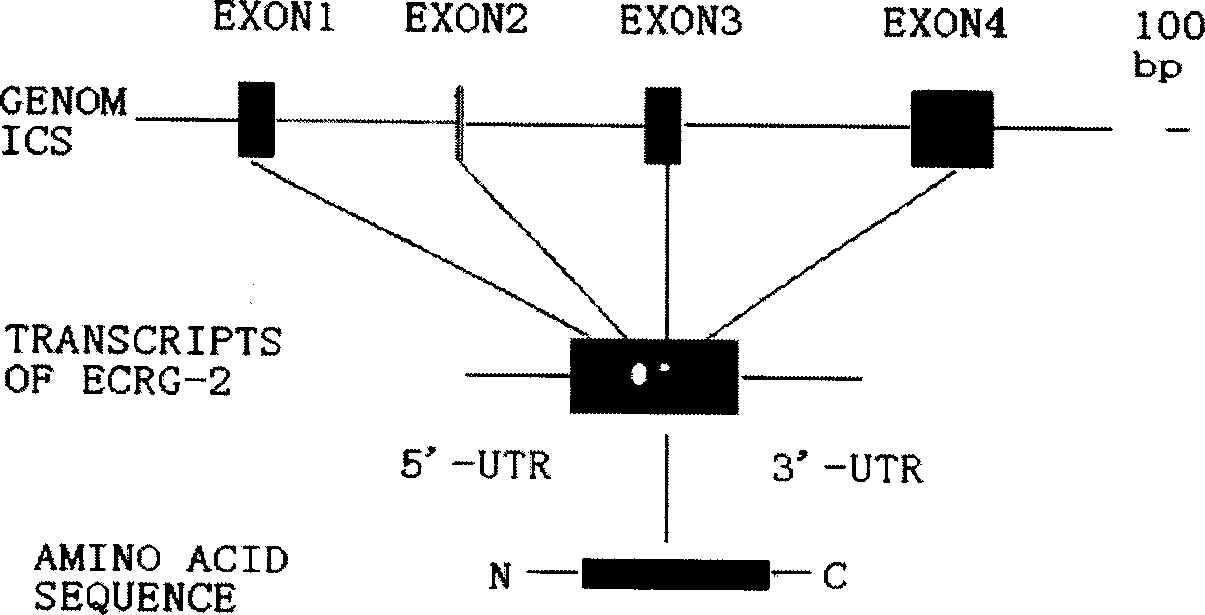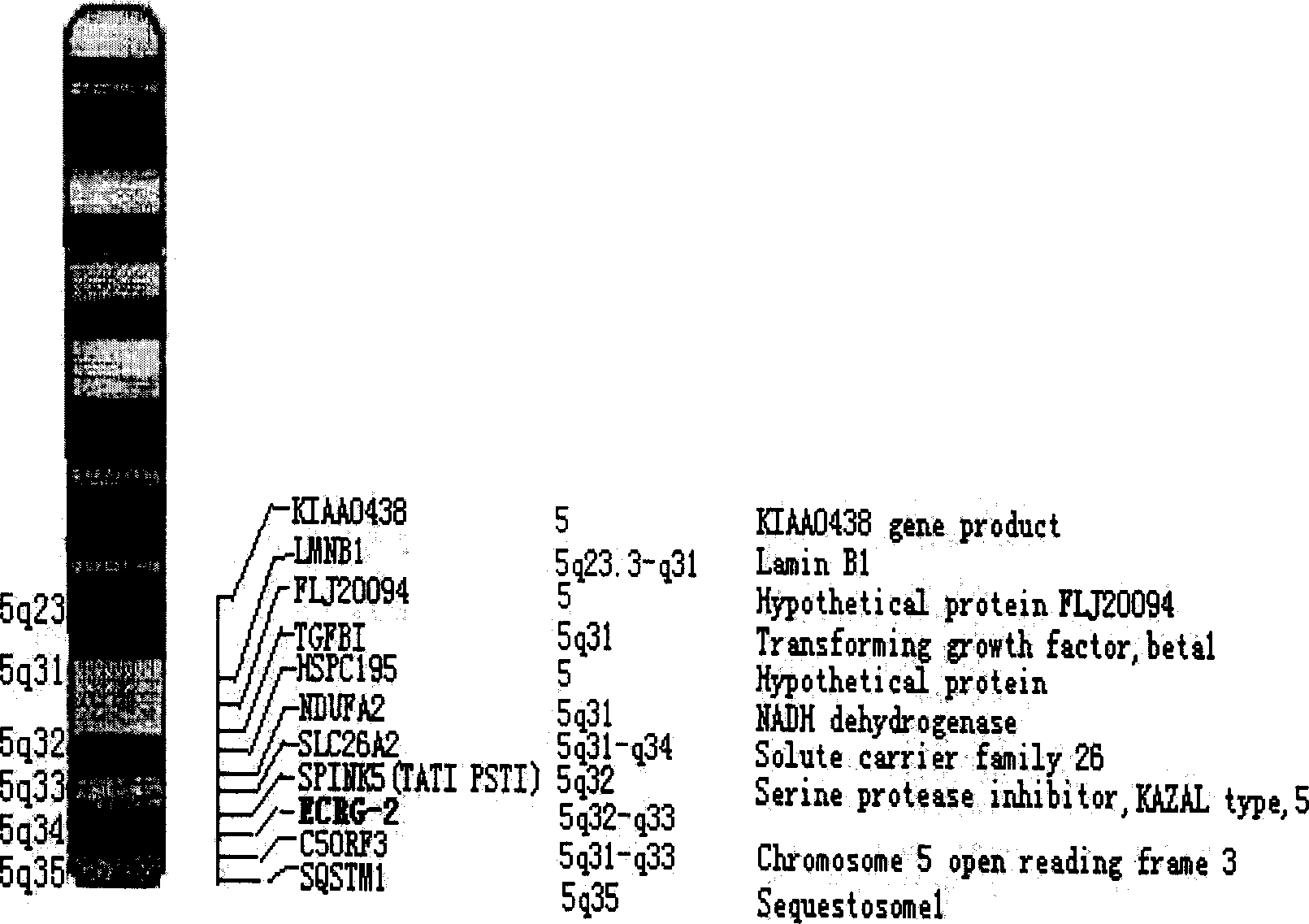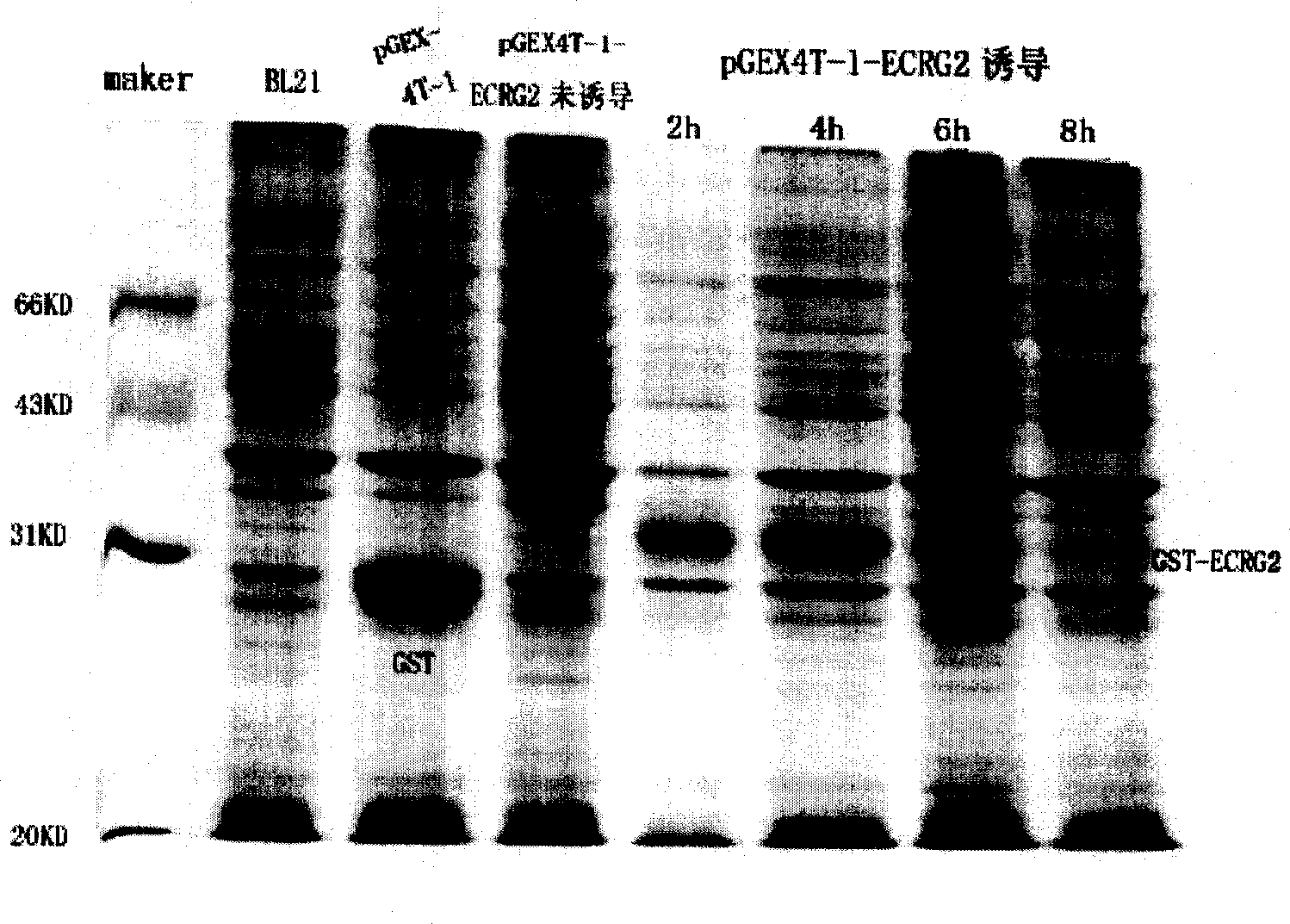Carcinoma of esophagus related gene-2 and use of coding protein thereof
A kind of use, recombinant plasmid technology, applied in gene therapy, medical preparations containing active ingredients, genetic material components, etc., can solve problems such as undiscovered genes
- Summary
- Abstract
- Description
- Claims
- Application Information
AI Technical Summary
Problems solved by technology
Method used
Image
Examples
Embodiment 1
[0082] The source and extraction and purification of ECRG-2 gene
[0083] mRNA differential display
[0084] (1) Extraction of total RNA (TotalRNA) from tissue samples
[0085] 1. Refer to "one-step extraction method of guanidine isothiocyanate" ("Modern Molecular Biology Experimental Technology" edited by Lu Shengdong, China Peking Union Medical College Press, 139-141), the specific steps have been modified.
[0086] Take 0.3g of frozen tissue specimen, grind it into powder in a mortar in the presence of liquid nitrogen, and transfer it to 3ml of solution D (4M guanidine isothiocyanate, 25mM sodium citrate pH7.0, 0.5% lauryl inosine Sodium phosphate, 100mM 2-mercaptoethanol) homogenate in a homogenizer (operate in an ice bath), transfer the homogenate into a 10ml centrifuge tube, and add in order: 0.3ml 2M sodium acetate pH4.0; 3ml water-saturated phenol; 0.6ml of heliumform-isoamyl alcohol (49:1), shake vigorously for 10 seconds immediately after capping, place in ice ba...
Embodiment 2
[0152] Expression of fusion protein encoded by ECRG2 gene in Escherichia coli
[0153] Obtaining ECRG-2 Gene by PCR
[0154] Obtain the ECRG-2 gene fragment encoding 85 amino acids. Add the following reagents to the PCR reaction tube.
[0155] Reagent per tube (ul)
[0156] TAKARALATaq 0.25ul
[0157] 10×LA BUFFER (Mg 2+ Plus) 2.5ul
[0158] dNTP (2.5mM) 4ul
[0159]DNA 1ul
[0160] ECRG-25'primer (10mM) 1ul
[0161] ECRG-23'primer (10mM) 1ul
[0162] wxya 2 O 14.75ul
[0163] 25ul
[0164] Put it in a PCR machine (2400 type of PE company): after denaturation at 94°C for 4 minutes, denaturation at 94°C for 30 seconds, annealing at 59°C for 45 seconds, extension at 72°C for 1 minute, a total of 35 cycles, and finally 72°C for 7 minutes, 4 ℃ insulation.
[0165] The amplification results were detected by 1% agarose gel electrophoresis.
[0166] Cloning and purification of PCR products
[0167] 1. Restriction endonuclease digestion of PCR products and vectors ...
Embodiment 3
[0205] Effect of ECRG2 Gene on Growth and Cell Cycle of Bel7402 Cells
[0206] Construction of recombinants
[0207] Use specific primers (ECRG-25'-primer: TGG G GAT CCC ATG AAG ATC ACTGGG GGT CTC; 3'-primer: TCG AAT TCC TTA GCA ACT TCC ATC GTG AAG) to do PCR amplification of ECRG-2 gene, using ECORI , Insert the vector pcDNA3.1(+) after digestion with BamHI. The recombinant was transformed into Escherichia coli DH5α, and the plasmid was extracted from the positive clone. The positive recombinant was identified by enzyme digestion and sent to the company for sequencing.
[0208] cell culture
[0209] The Bel7402 cell line was cultured in DMEM medium containing 10% newborn calf serum, 5% CO2, and 37°C.
[0210] Transfection experiment
[0211]1. Inoculate an appropriate amount of Bel7402 cells in a 35mm dish until it grows to 80% full. Dilute 2ug of pcDNA3.1(+)-ECRG2 into 100ul of serum-free DMEM medium (solution A), then dilute 5ul of LIPOFECTAMINE™ into 100ul of ...
PUM
 Login to View More
Login to View More Abstract
Description
Claims
Application Information
 Login to View More
Login to View More - R&D
- Intellectual Property
- Life Sciences
- Materials
- Tech Scout
- Unparalleled Data Quality
- Higher Quality Content
- 60% Fewer Hallucinations
Browse by: Latest US Patents, China's latest patents, Technical Efficacy Thesaurus, Application Domain, Technology Topic, Popular Technical Reports.
© 2025 PatSnap. All rights reserved.Legal|Privacy policy|Modern Slavery Act Transparency Statement|Sitemap|About US| Contact US: help@patsnap.com



